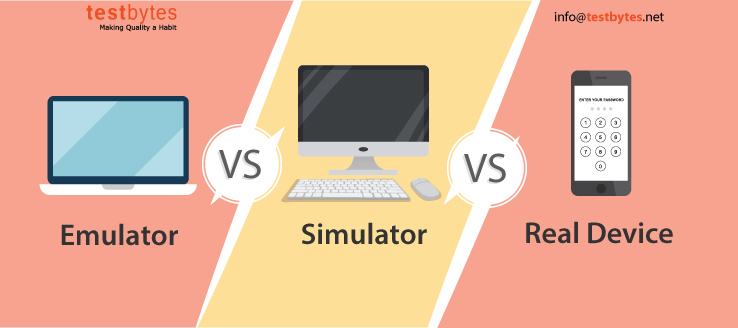
Emulator Vs Simulator : What is the Difference?
May 7th, 2019

In the current scenario of increasing mobile technology exploration of various aspect of artificial intelligence and machine learning is going hand in hand, use of the simulator and real device for the perfect running of the mobile when in the hand of the customer is not new.
As a basic practice, it is preferred that a developer should use an emulator for fast development and management of the applications whereas the testing team who needs to have all the quality checks made on time should use a real test device to be best assured.
What is Simulator?
- Sometimes to save on the cost factor companies introduce using a simulator or consider a virtual tool which can test as close to real, this allows the developers to have exploration of a wide base of applications which can work on the different geographical location across the globe. They are very cost efficient as they save the money of buying the real device.
What companies prefer currently
- However simulators and emulators are considered good for the initial stage development of the application but large companies which release finances and business related applications need to have perfect running applications without any defects, so they prefer working on the real-time devices before it goes to the production unit.
- For proper functioning, a balanced organization prefers to make strategies and plan their activities well in advance to determine the final outcome. This also allows them to choose the stage at which they have to introduce the real devices at their testing house.
- The best practice in the current technological drift is to use emulators for speeding up the debugging process and the better application coding while other features like smoke testing, network and performance should be done on the real devices.
For a clear picture of their difference, let us take a brief about what this testing device means.

What is the Real Testing Device?
- It is used for testing the functionality of your mobile applications in real device mode; they ensure that the working of the device application is smooth and convenient when in the hand of the consumer.
What is Emulator?
- These are basically the software programs which allow the mobile devices to initiate basic feature of another device like a computer or mobile software which you want to imitate on your own device by installing them.
What is the exact difference between the Emulator and Simulator testing?
- Both emulator and simulator are devices which are virtual in term of their usage. A device which is not real like a phone, but has software which gives similar functionality as that of a real phone is a simulator, except for few features like camera.
Let us see the key differences between Emulator and Simulator.
- Simulator-based testing has the main objective to simulate the internal state of the device as close as the internal state whereas emulators aim at the mimicking the outer behavior as similar as possible.
- The simulator is more referred where the team requires testing of the external behavior and pattern of the device for example calculations, whereas emulators are used where testing is on the internal behaviors’ and patterns like hardware.
- Simulators are based on the level of the high language and emulators are basically on machine level assembly.
- It is difficult to use a simulator for debugging on the other hand emulators is best at it.
- The simulator is nothing but just the original software re-implementation; emulator has it already in its complete form.
Emulator Testing differentiated against Real Device Testing
1. In terms of Application which are situation based
- Emulator testing is used for the specific situation which has a deadline of short duration and results have to be produced along with execution in a given time period. Sometimes it is necessary to use the emulator in circumstances which are relevant to a mobile application which is to be tested.
- In the real device, the tester has to test everything in all real-time scenarios for mobile applications. These devices operate by using fingers and simulate real-time usage. This allows the working of application in situations like bright sunlight or rainy day.
2. As close as Real handheld devices
- When the tester is not sure about the mobile devices which have to be used and how to invest in testing it creates the problem, so for people who have budgeted limit can go with emulator or simulator.
- A real device allows testers to use the look and feel of particular application both in night and day condition.
3. Ease of using
- Emulators or simulators are working on the cases which have free software backup and can be downloaded very easily through the web and are ready to be tested in a short period of the time.
- Real-time allows the tough testing options like working for continuous 10 to 15 hours which cannot be in the case of the emulator.
4. Using in term of Web Application and its opening through URL
- It is much easier for the user or tester as they have to do copy paste and the application is ready to be used.
- In real time devices testing requires fulfillment of more terms of reliabilities.
5. Ease of taking Snapshots and Screenshots in case of Defect Appearance
- Taking capture of various issues related to screenshots is easy in simulators as we have to use Microsoft office only.
- It is useful in cases of testing operating system which is more internal.
6. Batteries
- They are not helpful in simulating battery issues.
- Real devices can easily do it
7. Incoming Interrupts Validation
- Simulators are not made to interpret the incoming calls and SMS services.
- Real-time devices can do that conveniently.
8. Performance
- For the purpose of performance, simulators are proved to be much slower than the original mobile devices whereas the original devices are super fast.
9. Color Display
- Simulator fails to have the exact color display in terms of high configuration and in bright sunlight whereas original devices tend to perform much better when it comes to color display.
10. Memory
- The memory on the simulator or emulator is enormous and far large when compared to the real devices whereas in the real devices they are much lesser.
In terms of disadvantages real device and simulator both have their own drawbacks, in simulator tester cannot test the long term efficiency of the application, not suitable for certain type of test functions and executions, also tester team need to use software patches on the other hand real devices are hefty and costly, have timeline constraints and are harder to connect with the IDE which causes problem in the debugging.
Conclusion
A careful watch of pros and cons of using such a testing device system lead to a better conclusion which provides the optimal mobile solution related to testing which is necessary for strict, stringent and strong quality assurance.

So the basic idea goes with the optimal usage for both. The ultimate goal is to understand and study the market needs and develop a business-oriented use of these technologies.


 Software Testing Events
Software Testing Events App Testing
App Testing Web App Testing
Web App Testing Game Testing
Game Testing Automation Testing
Automation Testing Load Testing
Load Testing Security Testing
Security Testing Performance Testing
Performance Testing Hire a Tester
Hire a Tester





